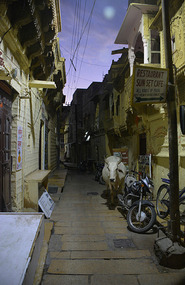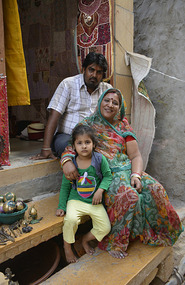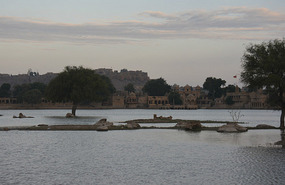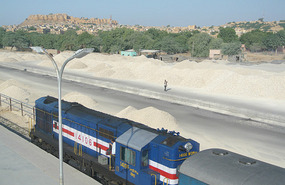After my excellent experience in Salawas, I was interested to see what the desert city of Jaisalmer held in store for me. Most visit Jaisalmer, as a staging post for a camel trip in the desert, but after a long memorable trip in Australia and subsequent treks by camel in the Sahara and the Gobi, I wasn’t interested. However this ancient desert city with its famous and unique sandstone fort rising out of the arid surroundings was a different matter all together. Plus some creature comforts like fruit juice, coffee and eggs were also on the menu.
The two Chhotaram Prajapats, both senior and junior drove me the 20 kms to Jodhpur station for my midnight train
. That was really appreciated and it was very kind and I said goodbye to them there. The midnight express for the five and a half journey to Jaisalmer was packed and there were four foreign travellers on board in various carriages. Two nice sisters from Argentina had a last minute ticket only in the public seated areas and probably had a sleepless night. For me I was in 3rd class sleeper, with some locals, eight people to a berth. No one was particularly talkative at that time of night and everyone went straight to sleep, to be up for the 5.25am arrival.
I was staying at the Mud Mirror Guesthouse inside the old Fort. This was a backpacker guesthouse in the walls of the fort overlooking the sand brick city, and was pretty basic. It was though good value and Lala (the manger - not named after a Teletubbie he informed me) was very friendly and a huge BJP supporter.
The tuk tuk journey up to the fort at 5.30 was memorable. We entered the washed cobbled streets of the fort and the startlingly atmospheric deserted sandstone ancient buildings were lit up with orange tinted streetlights. It was an early time to arrive and when I went onto the rooftop restaurant of the guesthouse for breakfast I found all the staff up there asleep on outside beds.
Later I went out to explore and found a thriving village inside this unique structure
. The streets were sometimes just the width of one or two cows at best, and the walkways were made with large stones. Old Havelis constructed in the local sandstone towered above these alleyways. Beautifully carved, these Haveli’s carvings survived well preserved thanks to the arid desert environment. Yet apart from the tourist boutiques and shops, the fort retained a local feel, with many carrying on with their business, religious activity and chores. Schools, temples, washrooms and loose cattle shared space with souvenir shops, travel agents, guesthouses and restaurants. It was great town to explore and the even better at 5.00-6.00 am on the following mornings as the streets were empty of tourists and those locals who were reliant on them.
It was on one of these morning whilst photographing the town, that I passed a solitary cow on a narrow street at 5.30. Not an unusual occurrence in itself, it was just that whilst I as passing the animal it lowered its head and head butted me with its (little) horns. Winded, I managed to stay upright and luckily the cow did not follow through with another attack. This act of aggression was noticed by a man cleaning his Haveli, who ran to my aid and pushed the psychotic cow away. Never again will I look at a harmless cow in the same way again - as I still have the bruises to show for the attack.
Outside the fort at the end of a winding access road through several dramatic gates, was the old town
. This winding narrow part of the city also had fabulous old bazaars, tailors, fruit sellers, hairdressers and the odd souvenir shop. Of course there was plenty of wandering cows and bulls plus other livestock (now I was much more weary). Rubbish (curiously absent in the fort) was back to prolific quantities in the old city. Nevertheless this old city was atmospheric as well, with an interesting street market and many food stalls at the end.
Surprisingly, I encountered relatively few tourists. Groups arrived by bus throughout the day, but there were few staying in and around the fort. Over lunch though I did met two backpackers from England. Joe and Rachael who had arrived in India ten days before. We got on well and had a great natter in an a wind cooled restaurant in the fort walls where they were staying. They introduced me to their guesthouse manager/guide called Rampat, a young man from a desert village who was organising their Camel safari, and who had a big interest in good street food
. Joe was in the food business in the UK so we soon ambled off with Rampat to the street market to feast on Aloe Tikki, Chili Pakorat and Pani Puri. These were not quite up to the standard of Salawas, but enjoyable nevertheless.
Another early morning amble around the fort was excellent and trouble free, plus I took some nice photos. I followed this with a leisurely breakfast and then an excellent coffee at the Italian Cafe - no less. I was finding the local shop owners pushy, but not overbearing which made this city all more enjoyable. I would also meet some nice and interesting locals, not connected with the tourist business. Kammel was a retired army officer in his 70s who had lived and worked all over India, but was from Jaisalmer and we had a long conversation about the country. Lala was also interesting on the subject of politics and the up and coming election (although his views were very pro BJP - the Hindu nationalist party). I also met a Mr Khan a local Muslim working as a caretaker in a neighbouring 400 year old Haveli. It is unusual to find a Muslim working inside the fort, but he was very friendly, made me a chai and showed me the Haveli in which he worked. He was also reasonably open in discussing his life as a Muslim in this part of India (difficult being so close to the Pakistan border).
On a further jaunt through the narrow streets I meet a Rajasthani woman called, Bobby. Bobby was not your typically subordinate Rajasthani woman. She had set up a charity, supporting neglected and abused village women, and was selling their handicrafts in Jaisalmer to the tourists, returning the money directly to these women. She explained to me that “no Rajasthani woman enjoys even a small degree of independence compared to women in many other states in India. And this is completely different to what rights women enjoy in most of the developed world.” She went on to tell me over a cup of chai, about her charity, the work she does, the women she supports and what has happened to her since she set up this business. She detailed how she is ostracized by her own family and the family of her husband, who have declared her charity is “mens work” and “no place for a woman”. She explained how she is shunned and actively campaigned against by all the shop owners and business owners (all men) within the fort, “because I am a women” She also detailed the discrimination that she has faced, the mental and physical abuse directed against herself and her women by men in Rajasthan and beyond. It was very interesting, harrowing and illuminating. We went on to discuss the recent violence perpetuated against women in India, the reaction of the politicians and lawyers plus the continuing calls for her to stop this work, and revert to being a “normal women”. She then introduced me to her three year old daughter and husband, Shiva, who admitted at the beginning to being some what perplexed by the women he had married (in an arranged marriage), but has supported her and recently stood up for her against family and business threats. This support was quite obviously invaluable to Bobby.
Bobby also explained that two years ago she had acquired support from a charity in Barcelona, to build a school in rural Western Rajasthan, where she will educate the children of her women in all subjects, hopefully with volunteer teachers from Europe and America. It was an inspirational meeting and I purchased a large piece of embroidery from her. I also introduced her to Joe and Rachael.
Later on I met my first Naga man. I am travelling onwards to Nagaland in the far north east of India over the next two months, and was very keen to strike up a conversation with this man. He did not look Indian, actually far from it and although he looked to me more like a Thai or Malaysian. I have since read that the origins of the Naga people may well be Sumatra. They all speak excellent English, are Baptists and fought with the English and Indian forces against the Japanese at the Battle of Kohima in 1944. They are famous for being headhunters up until the mid 1980s. He was very engaging when I established that he was not a tourist and grave me some great tips for my forthcoming visit.
I also met in that afternoon, Mr Parekh, owner of the “Light of the East” crystal and mineral shop in the winding streets. I initially entered just for a look, but Mr Parekh was a fountain of knowledge about all things stone & crystal, plus (strangely) cinema and we had a long interesting conversation over several cups of chai and two days. His hobby from a young age, was collecting stones and crystals, and his shop was full of them. Originally from Bengal, where he had rowed for university in the 1960s, his hobby had developed into a fully fledged business with now two shops, the other in Ladakh. I had never seen anything like this from the cut stones for jewelry right up to little thin bowls and cups made from stones sourced from throughout India and the World.
It was a complete labour of love, which now employed his whole extended family and an army of local stone cutters. He was exporting to London & New York amongst others. Behind his desk was a large photograph of Omar Sherif. “He is a customer and he gave me this as he said I resembled him.” He also had a large photo of Satyajit Ray, the famous Indian film director and the father of Indian film, who filmed his 1974 film ‘Sonar Kellar’ aka Golden Fortress in Jaisalmer and “the streets outside my shop. We became friends and I urge you to meet his son when you are next in Kolkata.” He was fascinating.
The next morning, early before I left Jaisalmer, I took a tuk tuk down to the Gadi Sagar lake on Lala’s recommendation to see the birds. Lala assured me there were “large numbers” and you will see the Hindu tradition of the temple guardians feeding the birds early in the morning at site termed the “parabdis”. This seemed a good opportunity to see what the tradition was, what was fed to the birds and what type of birds there actually were.
Gadi Sagar was on the outskirts of the new town, and the entrance was a rather nice looking gate that lead to a ghat and several tourist pleasure boats moored at the lake harbour. When I arrived at 6.00am the area was waking up. Many people were still asleep on their outside beds and the sparrows were certainly swarming in the trees. I walked around the gate and out along the lake shore, but saw no birds. The lake had some floating temples which were small but quite nice, nothing on Dungarpur. Around the other side of the lake, the mud flats (pretty dry in this climate) were silent and all I encountered was children, begging. I carried on until I spied some movement in the distance with a congregation of birds settling on a floating temple. Eventually behind the back of the temple a man emerged with a bag of seed and sprayed it all over a small piece of land at the waters edge. The closer I got, the more disappointed I became, when I realised that he was only feeding the pigeons. “Pigeons are holy” Lala later explained, after noticing my disappointment. The sunrise was at least impressive.
Jaisalmer and the Fort, was indeed exceptional and memorable and I left on the local train to Bikaner, thinking this run of great places to stay and memorable guesthouses could not continue......
Psychotic Cows, Nagas, Omar Sherif & Desert Forts
Thursday, September 26, 2013
 Jaisalmer, Rajasthan, India
Jaisalmer, Rajasthan, India
Other Entries
-
3Indian Visa Chaos and Arrival in Colombo
Jul 0781 days prior Colombo, Sri Lankaphoto_camera1videocam 0comment 6
Colombo, Sri Lankaphoto_camera1videocam 0comment 6 -
4Colombo, City of Curries and Cricket
Jul 1078 days prior Colombo, Sri Lankaphoto_camera3videocam 0comment 0
Colombo, Sri Lankaphoto_camera3videocam 0comment 0 -
5The Sri Lanka cloud forest.
Jul 1375 days prior Nuwara Eliya, Sri Lankaphoto_camera2videocam 0comment 3
Nuwara Eliya, Sri Lankaphoto_camera2videocam 0comment 3 -
6A Traditional Plantation House
Jul 2068 days prior Galagedera, Sri Lankaphoto_camera2videocam 0comment 1
Galagedera, Sri Lankaphoto_camera2videocam 0comment 1 -
7Baby Elephants, water & mud!
Jul 2464 days prior Giritale, Sri Lankaphoto_camera4videocam 0comment 6
Giritale, Sri Lankaphoto_camera4videocam 0comment 6 -
8Traffic Jams and Great Birdlife in National Parks
Jul 2563 days prior Tissamaharama, Sri Lankaphoto_camera4videocam 0comment 0
Tissamaharama, Sri Lankaphoto_camera4videocam 0comment 0 -
9Dinner Parties, Train Sets & Stilt Fisherman
Aug 0156 days prior Galle, Sri Lankaphoto_camera5videocam 0comment 1
Galle, Sri Lankaphoto_camera5videocam 0comment 1 -
10Negombo & Bangkok & Prickly Heat
Aug 0453 days prior Bangkok, Thailandphoto_camera3videocam 0comment 2
Bangkok, Thailandphoto_camera3videocam 0comment 2 -
11Phnom Penh, Palaces, Genocide & Pajamas
Aug 0948 days prior Phnom Penh, Cambodiaphoto_camera4videocam 0comment 2
Phnom Penh, Cambodiaphoto_camera4videocam 0comment 2 -
12More Elephants, Hoeing & Hello Kitty
Aug 1641 days prior Sen Monorom, Cambodiaphoto_camera3videocam 0comment 1
Sen Monorom, Cambodiaphoto_camera3videocam 0comment 1 -
13Prasat Preah Vihear, Soldiers & A Bordello
Aug 1839 days prior Preah Vihear, Cambodiaphoto_camera4videocam 0comment 0
Preah Vihear, Cambodiaphoto_camera4videocam 0comment 0 -
14Angkor Wat, orphans & getting wet.
Aug 2433 days prior Siem Reap, Cambodiaphoto_camera3videocam 0comment 0
Siem Reap, Cambodiaphoto_camera3videocam 0comment 0 -
15Tata, Trains, Taxis and Rickshaws. Chaos & Theft
Aug 3126 days prior Kolkata (Calcutta), Indiaphoto_camera6videocam 0comment 0
Kolkata (Calcutta), Indiaphoto_camera6videocam 0comment 0 -
16The Pink/Orange City, Masala Tea, Amber Fort
Sep 0818 days prior Jaipur, Indiaphoto_camera4videocam 0comment 1
Jaipur, Indiaphoto_camera4videocam 0comment 1 -
17Bundi, Dust, Forts and the real Rajasthan
Sep 1214 days prior Bundi, Indiaphoto_camera5videocam 0comment 0
Bundi, Indiaphoto_camera5videocam 0comment 0 -
18Maharajas, Lakes, Vintage Cars and Birds
Sep 1511 days prior Udaipur, Indiaphoto_camera5videocam 0comment 0
Udaipur, Indiaphoto_camera5videocam 0comment 0 -
19Big Moustaches, Street Food & Big Forts
Sep 206 days prior Salawas, Indiaphoto_camera6videocam 0comment 0
Salawas, Indiaphoto_camera6videocam 0comment 0 -
20Psychotic Cows, Nagas, Omar Sherif & Desert Forts
Sep 26 Jaisalmer, Indiaphoto_camera4videocam 0comment 0
Jaisalmer, Indiaphoto_camera4videocam 0comment 0 -
21Special Blog: Seva Ram & Jitu Solanki
Oct 015 days later Bikaner, Indiaphoto_camera5videocam 0comment 0
Bikaner, Indiaphoto_camera5videocam 0comment 0 -
22Public Speaking, Painted Havelis and lots of rats!
Oct 048 days later Mandawa, Indiaphoto_camera8videocam 0comment 0
Mandawa, Indiaphoto_camera8videocam 0comment 0 -
23National Parks, Road Rage, Drunks & a Tiger!
Oct 1216 days later Bharatpur, Indiaphoto_camera4videocam 0comment 2
Bharatpur, Indiaphoto_camera4videocam 0comment 2 -
24Mosques, Cremations, Festivals & Dhal
Oct 2125 days later Varanasi, Indiaphoto_camera7videocam 0comment 0
Varanasi, Indiaphoto_camera7videocam 0comment 0 -
25Nepal, trekking, Cold, Everest and Gurkas
Oct 2832 days later Kayakatta, Nepalphoto_camera4videocam 0comment 0
Kayakatta, Nepalphoto_camera4videocam 0comment 0 -
26Karmi Farm, Sherpa Tenzing, Mr Happy and Momos
Nov 0540 days later Darjeeling, Indiaphoto_camera4videocam 0comment 0
Darjeeling, Indiaphoto_camera4videocam 0comment 0 -
27Rhinos, Armed Guards & Posing For Photos
Nov 1449 days later Kaziranga National Park, Indiaphoto_camera5videocam 0comment 0
Kaziranga National Park, Indiaphoto_camera5videocam 0comment 0 -
28Spiders, The Kharsi, Archery and Bad Driving
Nov 2055 days later Cherrapunji, Indiaphoto_camera5videocam 0comment 0
Cherrapunji, Indiaphoto_camera5videocam 0comment 0 -
29Monpas, Sumo, Yak Butter Tea & Indian Army
Nov 2459 days later Tawang, Indiaphoto_camera7videocam 0comment 0
Tawang, Indiaphoto_camera7videocam 0comment 0 -
30Uncles, Nuns, Bridges, Red Rice and Gompas
Nov 2762 days later Sakti, Indiaphoto_camera5videocam 0comment 0
Sakti, Indiaphoto_camera5videocam 0comment 0 -
31Buddhist Festival, Feral Dogs, Exploding Cakes
Dec 0166 days later Bomdila, Indiaphoto_camera6videocam 0comment 0
Bomdila, Indiaphoto_camera6videocam 0comment 0 -
32A Horror Journey
Dec 0368 days later Tezpur, Indiaphoto_camera4videocam 0comment 0
Tezpur, Indiaphoto_camera4videocam 0comment 0 -
33Hornbill Festival, Nagas & Nagaland
Dec 1075 days later Kohima, Indiaphoto_camera6videocam 0comment 3
Kohima, Indiaphoto_camera6videocam 0comment 3 -
34Pied Pipers, Hard Beds, Ao and Chang tribes
Dec 1883 days later Mokokchung, Indiaphoto_camera7videocam 0comment 0
Mokokchung, Indiaphoto_camera7videocam 0comment 0 -
35Battles, Monoliths, Street Photography, Home
Jan 0197 days later Dubai, United Arab Emiratesphoto_camera6videocam 0comment 0
Dubai, United Arab Emiratesphoto_camera6videocam 0comment 0 -
36Athens, Bristol, Doctors and Rain - lots of rain
Jan 15111 days later Athens, Greecephoto_camera2videocam 0comment 0
Athens, Greecephoto_camera2videocam 0comment 0 -
37Addis, Bus Travel, Malibu Storks and Lake Storms.
Feb 01128 days later Addis Ababa, Ethiopiaphoto_camera4videocam 0comment 0
Addis Ababa, Ethiopiaphoto_camera4videocam 0comment 0 -
38Minibuses, Police, Impounding, Gon
Feb 05132 days later Awasa, Ethiopiaphoto_camera4videocam 0comment 0
Awasa, Ethiopiaphoto_camera4videocam 0comment 0

 Jaisalmer, Rajasthan, India
Jaisalmer, Rajasthan, India











2025-05-22